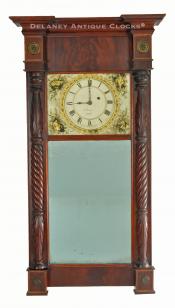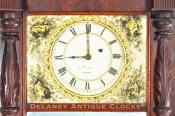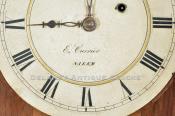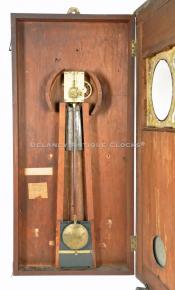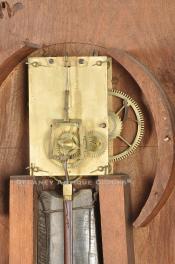Edmund Currier of Salem, Massachusetts. An outstanding mahogany cased mirror clock. UU-33.
This formal wall timepiece or more commonly called a Mirror clock, was made by Edmund Currier in Salem, Massachusetts.
This mirror clock case is constructed in mahogany, and the joinery remains tight and neat. The forward-facing flat surfaces are veneered with figured panels. The grain patterns selected for these locations are vibrant. The top of the case is fitted with an overhanging cornice molding that is nicely shaped. The carved columns are expertly carved. The carvings are crisp. All of this wood retains an older finish. A large rectangular-shaped mirror is positioned in the lower section of the door. It is the original mirror and remains in excellent condition. A decorative reverse-painted tablet provides a frame for the dial. This glass is colorfully decorated with white, green, black, and gold leaf. It is painted from the back, and the artwork frames the dial. The primary theme is the four conch shells. One is located in each corner. The center of the glass is left undecorated to view the dial. The front of the case opens in the manner of a door to access the interior of the case. The painted iron dial is signed by the Clockmaker. It reads, ” E. Currier / SALEM.” The time is indicated by the two skilfully hand-filed steel hour and minute hands. The time ring is marked out with Roman-style hour numerals. Behind the dial is a brass movement. It is weight driven and designed to run for eight days on a full wind. The teeth are skillfully cut, and the plates are nicely finished. The escapement is a recoil. This movement is mounted on top of two rails. These also form a guide for the lead drive weight. The pendulum retains its original wooden rod and brass-covered pendulum bob.
This clock measures approximately 38.5 inches long, 21 inches wide, and 6.5 inches deep. It was made circa 1830.
This outstanding example is inventory number UU-33.
Edmund Currier was born the son of a Doctor on May 4, 1793, in Hopkinton, New Hampshire. He lived until the age of 60 years young and died in Salem, Massachusetts, on May 17, 1853. His first shop was located in Hopkinton. This shop was previously owned by Philip Brown, who was also a clockmaker. As a result, it is thought that Brown may have trained Edmund in the clockmaking trade. There is also some evidence that suggests that he worked for a short period of time with either the Hutchins brothers or Timothy Chandler in Concord. Interestingly, Edmund’s account books for the period in which he worked in Hopkinton have survived. Today, this book is located in the New Hampshire Philomatic and Antiquarian Society of Hopkinton. This account book provides us with a synopsis of the businesses he conducted there. He lists manufacturing and repairing items such as spectacles, cutlery, tableware, and jewelry. He did locksmith work, gunsmith repairs, and manufactured instruments for doctors. He dealt in musical instruments. His brother Ebenezer was a piano maker. Edmund manufactured and repaired tools, wagons, sleighs, and harnesses. He was also a fine clockmaker and repaired some watches. A small number of clocks are listed as being made in this New Hampshire location. In fact, Currier lists in his account books that he purchased tall clock cases from David Young and David Young Jr. It appears that he purchased 10 cases from David Young and one from David Young Jr. They are listed as follows:
Clock cases purchased from David Young,
1.) July 11, 1816 clock case $35.00.
2.) January 1, 1817 cherry case $16.00
3.) May 27, 1817 clock case $20.00
4.) July 11, 1818, case in cherry for $16.00.
5.) June 1, 1817, in cherry for $16.00.
6.) July 11, 1818, in cherry for $16.00.
7.) November 6, 1818, a mahogany case for $25.00.
8.) November 12, 1818, he purchased a mahogany case for $25.00
9.) November 12, 1818, he purchased a birch case for $14.00
10.) May 24, 1820, a cherry case $14.00.
Clock case purchased from David Young Jr.,
1.) June 28, 1816, he purchased one cherry case for $16.00.
From the same account books, it is recorded that he sold eight case clocks. Prices range from $35.00 to $65.00.
Edmund moved from Hopkinton in 1825 to the corner of Essex and Central Streets in Salem, Massachusetts. In 1828, he moved his business to 7 Derby Square. This was centrally located “In the market.” In 1831, Currier formed a partnership with George B. Foster. Currier trained Foster. This partnership was located at 11 Derby Square. The firm of Currier & Foster lasted until 1835. The clocks made during this period are usually signed “Currier & Foster.” This firm advertised as having for sale watches, clocks, and timepieces of their own manufacture. They are also listed as jewelers. After 1835, Currier continues to advertise on his own. His business is now located on Essex Street, and he was still in the business of making and selling “Timepieces, Gallery-Clocks, Regulators...” While in the town of Salem, Currier was deeply involved with the Salem Charitable Mechanic Association. It was recorded by his associates that he was “accustomed to working sixteen hours out of twenty-four.” He was admired for his talents.
Very few clocks by Currier and Currier & Foster are known. Examples are difficult to come by. Several other timepieces, as well as a lyre form, a dwarf form, and less than a hand full of tall clocks, are reported. There is a tall case clock in the museum collection at the Essex Institute, and we currently own what may be the only Hopkinton signed example. For a more complete listing of these Makers, please review “Willard’s Patent Timepieces,” written by Paul J. Foley.

